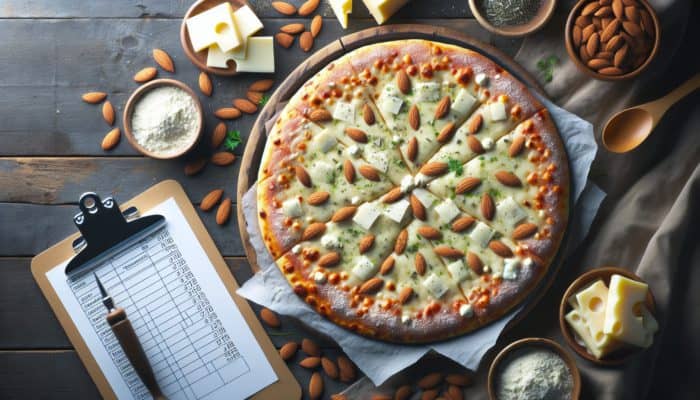Discover the World of Low-Carb Pizza Dough
What Is Low-Carb Pizza Dough All About?

Best Low-Carb Pizza Dough Recipes: Low-carb pizza dough represents a revolutionary alternative to conventional pizza bases, specifically designed for individuals who aim to limit their carbohydrate intake while still enjoying a delightful meal. This innovative dough is especially favoured by those adhering to low-carb or ketogenic diets, where the focus is on minimising carbohydrate consumption to facilitate weight loss and regulate blood sugar levels. By incorporating alternative flours and ingredients, low-carb pizza dough achieves a satisfying texture and flavour, ensuring that you can still enjoy your preferred dishes without guilt.
Furthermore, the adaptability of low-carb dough opens a myriad of opportunities for crafting various pizza styles, ranging from the classic Margherita to more exotic toppings that cater to diverse palates. The secret is in selecting the right combination of ingredients to create a dough that not only tastes fantastic but also aligns with dietary restrictions.
What Are the Benefits of Using Low-Carb Dough?
Opting for low-carb dough brings forth a multitude of benefits, making it an attractive option for many. One of the primary advantages is its ability to help manage blood sugar levels. Standard pizza dough is often laden with refined carbohydrates, which can trigger spikes in blood sugar, particularly for individuals with diabetes or insulin resistance. Low-carb alternatives help counteract this effect, providing a more stable source of energy throughout the day.
Additionally, integrating low-carb dough into your meals can bolster your weight loss journey. By minimising carbohydrate consumption, your body may transition into a state of ketosis, where it utilises fat as fuel instead of sugar. This metabolic shift not only aids in shedding pounds but can also enhance mental clarity and focus. For those adhering to restrictive diets, low-carb pizza dough offers a satisfying meal option that does not compromise on flavour or enjoyment.
What Ingredients Are Essential for Low-Carb Pizza Dough?
When it comes to creating the perfect low-carb pizza dough, the selection of ingredients is paramount. Commonly utilised components include almond flour, coconut flour, cheese, and eggs.
- Almond flour: This gluten-free flour is low in carbohydrates and rich in protein and healthy fats, imparting a delightful nutty flavour and a pleasing texture.
- Coconut flour: A versatile alternative that provides a subtle coconut taste, it is highly absorbent and often necessitates more liquid than other flours.
- Cheese: Typically mozzarella or cream cheese, it contributes richness and helps bind the dough, enhancing both flavour and texture.
- Eggs Serve as a binding agent, providing structure and moisture to the dough, making it more manageable during preparation.
Together, these ingredients yield a dough that is not only low in carbs but also rich in taste and satisfaction, paving the way for boundless culinary exploration.
Gain Expert Insights into Top Low-Carb Pizza Dough Recipes

What Are Real-World Examples of Successful Low-Carb Pizza Recipes?
In the realm of low-carb pizza dough, numerous recipes have garnered praise from both culinary experts and passionate home cooks. Here is a selection of tried-and-true favourites that exemplify the versatility of low-carb ingredients:
- Almond Flour Pizza Crust: Crafted with almond flour, mozzarella cheese, eggs, and seasonings, this crust achieves a delightful texture that is both heavy and crisp
- Coconut Flour Pizza Base: A blend of coconut flour, eggs, and cheese yields a light base that boasts a subtle coconut flavour, perfect for those with adventurous tastes.
- Cauliflower Pizza Crust: Grated cauliflower combined with cheese and eggs creates a gluten-free, vegetable-packed option that is both nutritious and flavourful.
- Fathead Dough: A popular selection made from almond flour and mozzarella, yielding an impressively stretchy and satisfying dough.
These examples not only highlight the diverse array of ingredients available but also demonstrate how easy it is to prepare a delectable low-carb pizza base at home.
What Are the Actionable Steps for Preparing Low-Carb Dough?
Crafting low-carb pizza dough is a straightforward process that anyone can master with a few simple steps. Here’s how to efficiently prepare your dough:
- Mix the Ingredients: Begin by combining your chosen flour (almond or coconut), cheese, eggs, and any desired seasonings in a mixing bowl until everything is well-blended
- Knead the Dough: After mixing, knead the dough until it achieves a smooth consistency, ensuring that all components are thoroughly incorporated.
- Roll Out the Dough: Place the dough on a floured surface and roll it out to your desired thickness, keeping in mind that thinner crusts will yield a crunchier texture.
- Preheat Your Oven: While preparing the dough, preheat your oven to the recommended temperature, typically around 220°C, for optimal baking results.
By adhering to these steps, even novices can produce remarkable outcomes, creating a low-carb pizza crust that is both fulfilling and versatile.
How Do You Achieve the Ideal Dough Texture and Taste?

The texture and flavour of low-carb pizza dough are pivotal elements that can significantly influence the overall pizza experience. Attaining the perfect dough necessitates an understanding of ingredient balance. For example, the combination of almond flour and mozzarella cheese creates a slightly chewy texture, reminiscent of traditional pizza dough. In contrast, coconut flour can introduce a lightness that some may prefer.
When evaluating taste, the addition of herbs and spices, such as garlic powder or Italian seasoning, can remarkably enhance the flavour profile. An expert tip is to experiment with different types of cheese; incorporating cream cheese can yield a creamier texture, while a blend of cheeses can provide a more complex flavour experience.
Ultimately, the ideal low-carb pizza dough strikes a harmonious balance between texture and taste, ensuring that every mouthful is both satisfying and delicious.
What Variations and Customisation Options Are Available?
The true beauty of low-carb pizza dough lies in its flexibility to accommodate various dietary preferences and flavour profiles. There are countless variations and customisation options to explore, allowing you to tailor recipes to your tastes.
For those who enjoy culinary experimentation, consider incorporating spices right into the dough. Adding crushed red pepper flakes can introduce a delightful kick, while Italian herbs can infuse an aromatic essence. Additionally, consider replacing traditional mozzarella with other cheese varieties, such as cheddar or parmesan, to alter the flavour and texture profile you're looking for. If you're looking for a nut-free alternative, consider using almond flour or flaxseed as a substitute. These substitutes offer unique flavours and nutritional benefits while maintaining low-carbohydrate count
The possibilities with low-carb pizza dough are virtually limitless, enabling you to create a dish that perfectly aligns with your culinary preferences and dietary needs.
How Do You Make Low-Carb Pizza Dough?
What Are the Basic Steps for Making Low-Carb Pizza Dough?
Creating low-carb pizza dough consists of several straightforward steps that help ensure a successful outcome. Adhere to these fundamental guidelines to craft your dough:
- Gather Your Ingredients: Begin by assembling all the necessary ingredients, including your preferred low-carb flour, cheese, eggs, and any desired seasonings.
- Mix the Dough: Begin by combining the dry ingredients,. Then, add the cheese and eggs, mixing until a cohesive dough is formed. The Dough: Knead the mixture for a few minutes until it becomes smooth and elastic, ensuring even distribution of all ingredients.
- Rest the Dough: Allow the dough to rest for approximately 10-15 minutes, as this allows it to improve its texture and makes it easier to roll out.
- Roll Out and Shape: Once rested, roll out the dough to your preferred thickness and shape, getting it ready for baking.
By following these steps, you can create a low-carb pizza dough that is both flavourful and easy to prepare, setting the stage for delightful homemade pizzas.
Can You Use a Food Processor for Making Low-Carb Dough?
Utilising a food processor can significantly streamline the process of creating low-carb pizza dough. This convenient kitchen appliance enables you to mix and knead ingredients quickly, saving valuable time for busy home cooks. To use a food processor, add the dry ingredients first, followed by the cheese and eggs, then pulse until the mixture forms a cohesive ball of dough.
This method not only reduces preparation time but also ensures that ingredients are evenly incorporated, which is crucial for achieving the desired texture. For those who find traditional mixing methods cumbersome, a food processor is a game-changer, enabling you to whip up low-carb pizza dough in mere minutes.
How Long Should the Dough Rest for Optimal Results?
Allowing your low-carb pizza dough to rest is a crucial step that can substantially enhance its texture. A resting period of approximately 10-15 minutes is ideal, as it permits the ingredients to meld and the gluten structure to relax. When gluten is given the chance to rest, the dough becomes more pliable and easier to roll out, which is essential for achieving even thickness.
During this resting phase, the starches in the flour also get the opportunity to hydrate fully, resulting in a better overall structure once baked. Neglecting to rest the dough can lead to a tougher texture and make shaping it more challenging. Thus, granting your dough a moment to relax is an integral step in crafting a delicious low-carb pizza crust.
What Ingredients Are Indispensable in Low-Carb Pizza Dough?
When formulating low-carb pizza dough, certain ingredients are essential for ensuring a successful and flavourful outcome. The following components are crucial:
- Almond flour: This primary flour used in many low-carb recipes offers a subtle nutty flavour and low carbohydrate content.
- Mozzarella cheese: Essential for binding the dough and adding richness, mozzarella aids in achieving a stretchy, chewy crust.
- Eggs:, actingas a binder, erovide structure and moisture, facilitating ease of handling during preparation.
- Seasonings: Incorporating herbs and spices like garlic powder, oregano, or basil enhances the flavour and aroma of the crust.
Together, these ingredients form the foundation of a delectable low-carb pizza dough that can satisfy even the most discerning pizza lovers.
What Are the Steps for Baking the Dough to Perfection?
Baking your low-carb pizza dough to perfection involves a few key steps to ensure a crispy and flavourful crust. Start by preheating your oven to 220°C, allowing it to reach the optimal temperature for effective baking. Once your dough is rolled out to your desired thickness, place it on a baking sheet lined with parchment paper or a greased pizza stone.
Bake the crust for approximately 10-15 minutes or until it achieves a golden brown colour. This initial baking period helps set the structure of the dough, ensuring it can withstand the weight of your toppings without becoming overly soft or soggy. To achieve the best texture, monitor the crust during the final minutes of baking, as oven temperatures may vary.
By adhering to these baking instructions, you will create a low-carb pizza crust that is not only delicious but also possesses a satisfying crunch that perfectly complements your favourite toppings.
What Are the Best Ingredients for Low-Carb Pizza Dough?
Why Is Almond Flour a Preferred Choice?
Almond flour serves as a fundamental ingredient in numerous low-carb pizza dough recipes, celebrated for its myriad health benefits and culinary flexibility. Its low carbohydrate content, compared to traditional wheat flour, makes it an excellent choice for individuals seeking to reduce their carbohydrate intake. Almond flour is abundant in nutrients, delivering essential vitamins and minerals, healthy fats, and substantial protein, making it a nourishing addition to any diet.
Incorporating almond flour into your pizza dough not only boosts its nutritional value but also imparts a subtle nutty flavour and a satisfying texture. The grainy consistency of almond flour provides a pleasant chew that mirrors the experience of traditional pizza, making it a favourite among those on low-carb diets. Its versatility extends beyond pizza dough, as it can be employed in various baked goods, allowing for an expansive range of culinary creativity.
Is Coconut Flour an Effective Alternative?
Coconut flour is another superb option for low-carb pizza dough, renowned for its absorbent qualities and mild coconut flavour. While it differs significantly from almond flour in texture and moisture retention, it offers a unique profile that can be advantageous in certain recipes. One of the standout benefits of coconut flour is that it is naturally gluten-free, making it an appealing choice for those with gluten sensitivities or allergies.
However, it’s important to acknowledge that coconut flour requires a higher liquid-to-flour ratio, necessitating adjustments when incorporating it into pizza dough recipes. A good rule of thumb is to use roughly one-quarter of the amount of coconut flour compared to other flours, increasing the liquid content accordingly. This adjustment ensures the dough maintains the correct consistency while still delivering a delightful texture and flavour.
Can You Enhance the Dough by Adding Cheese?
Incorporating cheese into low-carb pizza dough is not only permissible but often encouraged, as it can significantly elevate both the flavour and texture of the crust. Cheese, especially mozzarella, contributes to the dough’s elasticity, allowing it to stretch and hold together during baking. This characteristic mimics traditional pizza crusts, making it an aappealing optionfor those iseekingla ow-carb salternative
Adding cheese to the dough can also create a rich, savoury flavour that enhances the overall pizza experience. For those who prefer a cheesier base, consider experimenting with different cheese varieties, such as cheddar or parmesan. This flexibility allows you to customise the taste of your pizza crust while adhering to low-carb dietary guidelines.
Moreover, the inclusion of cheese not only boosts flavour but also adds nutritional benefits, providing protein and calcium, making your low-carb pizza a more balanced meal.
Proven Strategies for Crafting Exceptional Low-Carb Pizza Dough
How to Effectively Experiment with Different Flours?
One of the most thrilling aspects of creating low-carb pizza dough lies in the opportunity to experiment with various types of low-carb flours. Each flour brings unique characteristics to the dough, allowing you to customise your pizza base to your taste preferences. For instance, blending almond flour with coconut flour can produce a more intricate texture while lowering the overall carbohydrate count.
When venturing into experimentation, consider trying a mix of flours, such as flaxseed meal or pea protein flour, which can introduce a distinct flavour profile and nutritional benefits. Each combination will yield different results regarding texture and taste, so take notes on your experiments to identify which blends work best for you. This approach not only enhances your baking skills but also broadens your culinary horizons.
What Are the Best Practices for Adjusting Hydration Levels?
Adjusting the hydration levels of your low-carb pizza dough is crucial for achieving the perfect texture. Proper hydration guarantees that the dough is neither too dry nor excessively sticky, both of which can lead to unsatisfactory results. When using flours such as coconut flour, which absorb more moisture, it’s essential to find the right balance of liquid to dry ingredients.
Begin by adding a small amount of liquid and gradually increase it until you achieve a workable dough consistency. If your dough appears too dry, incorporate a tablespoon of water or egg until you reach the desired texture. Conversely, if it’s overly sticky, adding a touch more flour can rectify the issue. Balancing hydration levels is crucial for producing a low-carb pizza dough that is easy to work with and yields the ideal crust.
How to Incorporate Flavour Enhancers into Your Dough?
To elevate your low-carb pizza dough, including flavour enhancers such as herbs and spices can make a remarkable difference. Adding dried herbs like oregano, basil, or thyme directly into the dough infuses each bite with aromatic flavours that beautifully complement your pizza toppings.
Additionally, consider incorporating garlic powder or onion powder for an extra layer of taste that amplifies the overall flavour profile. These simple additions can transform a basic dough into a culinary delight, making it more enjoyable and satisfying to eat. The beauty of low-carb pizza dough lies in its versatility, allowing you to experiment with various flavour combinations until you discover the perfect mix that resonates with your palate.
How to Optimise Yeast and Leavening Agents for Better Results?
Utilising the appropriate amount of yeast or alternative leavening agents is essential for enhancing the rise and texture of your low-carb pizza dough. While traditional pizza recipes frequently depend on yeast for leavening, low-carb alternatives can also utilise baking powder or baking soda to achieve a similar effect.
If you decide to use yeast, allow the dough to rise for a designated period (if your recipe specifies), which can contribute to a lighter texture. However, many low-carb recipes often omit this step due to the lack of high-carb ingredients. When using baking powder, ensure it is included in the dry ingredients and follow the recommended ratios for optimal results.
Experimenting with various leavening agents will enable you to determine which method produces the best texture and flavour for your low-carb pizza crust, enhancing your cooking experience.
Expert Tips for Perfecting Your Low-Carb Pizza Dough
How to Achieve the Right Dough Thickness?
Achieving the ideal thickness for your low-carb pizza dough is vital for a gratifying pizza experience. The thickness of the dough can significantly influence both texture and cooking time, making it essential to find a balance that suits your preferences. Use a rolling pin to evenly roll out the dough, applying consistent pressure to ensure uniform thickness.
For a crispier crust, opt for a thinner dough, while a thicker crust provides a chewier base. Keep in mind that thickness will also affect cooking times; thinner crusts may require fewer minutes in the oven compared to thicker ones. A good practice is to start with a thickness of about 1/4 inch and adjust based on your preferences. This method will help you achieve the perfect equilibrium of texture and flavour.
Should You Consider Pre-Baking Your Crust?
Pre-baking your low-carb pizza crust is a highly recommended technique that can significantly enhance the final product. This method helps prevent the crust from becoming soggy after topping, ensuring a crispy and delightful base for your pizza. By pre-baking the crust for about 10-15 minutes before adding your chosen toppings, you allow the dough to firm up, creating a solid foundation.
During this initial baking phase, please keep a close watch on the crust to ensure it doesn’t brown excessively. The aim is to reach a slightly golden colour without fully cooking it, as it will continue to bake once the toppings are added. Pre-baking your crust is a valuable tip for anyone seeking to perfect their low-carb pizza experience.
What Common Mistakes Should Be Avoided?
When crafting low-carb pizza dough, avoiding common errors can lead to a more successful outcome. One frequent mistake is overmixing the dough, which can result in a dense texture instead of the light and airy crust you desire. Mixing just until combined is typically sufficient.
Another common error is using too much liquid; as low-carb flours vary in absorbency, it's vital to start with less and incrementally add more as necessary. Failing to allow the dough to rest can also impact its pliability and texture, resulting in a tougher crust.
By being aware of these prevalent pitfalls, you can enhance your low-carb pizza-making skills, ultimately resulting in a more delicious pizza that aligns with your dietary objectives.
Frequently Asked Questions About Low-Carb Pizza Dough
What Ingredients Are Used in Low-Carb Pizza Dough?
Low-carb pizza dough is typically crafted from ingredients such as almond flour, coconut flour, eggs, and cheese, which combine to form a delectable and low-carb alternative to traditional dough.
Can Low-Carb Pizza Dough Be Frozen?
Yes, low-carb pizza dough can be frozen. Wrap it tightly in plastic wrap and store it in an airtight container for up to three months. Thaw in the fridge before rolling it out.
Is Low-Carb Pizza Dough Gluten-Free?
Yes, most low-carb pizza dough recipes made with almond flour or coconut flour are gluten-free, making them suitable for individuals with gluten sensitivities or celiac disease.
How Many Carbs Are Present in Low-Carb Pizza Dough?
The carbohydrate content in low-carb pizza dough varies depending on the ingredients used. Still, it typically ranges from 2 to 5 grams of net carbs per serving, which is significantly lower than that of traditional pizza dough.
Can Low-Fat Cheese Be Used in the Dough?
You can incorporate low-fat cheese into low-carb pizza dough; however, it may impact the texture and flavour. Full-fat cheese generally yields better results in terms of taste and consistency.
How Long Can Cooked Low-Carb Pizza Be Stored?
Cooked low-carb pizza can be stored in the refrigerator for up to three days. Ensure it is kept in an airtight container to maintain its freshness.
What Toppings Are Suitable for Low-Carb Pizza?
Low-carb pizza can accommodate a variety of toppings, including low-carb vegetables, meats, cheeses, and sauces. Popular choices include pepperoni, olives, bell peppers, and mozzarella.
Can Low-Carb Pizza Dough Be Made Without Cheese?
Yes, low-carb pizza dough can be made without cheese; however, the texture and flavour may differ. Consider using additional binders, such as flaxseed meal or chia seeds, to maintain structure.
Is Low-Carb Pizza Dough Kid-Friendly?
Many children enjoy low-carb pizza dough, especially when topped with their favourite ingredients. It can serve as a healthier alternative for families aiming to reduce carbohydrate intake.
How Can the Taste of Low-Carb Pizza Dough Be Enhanced?
To boost the flavour of low-carb pizza dough, incorporate herbs, spices, or garlic powder into the mix. Experimenting with different cheeses can also significantly elevate the taste profile.



This exploration of low-carb pizza dough is incredibly timely, especially as more people look for ways to enjoy their favorite foods while staying mindful of their dietary choices. I can relate to the challenge of finding delicious alternatives that fit within a low-carb or ketogenic framework. It was a game-changer for me when I discovered that ingredients like almond flour or cauliflower could yield such satisfying textures—who would’ve thought, right?
Your experience really resonates with me. It’s amazing how finding creative substitutes can transform our favorite comfort foods, making them fit our lifestyles while still being enjoyable. Almond flour and cauliflower are definitely game-changers, adding both unique flavors and textures that keep the spirit of pizza alive.
I completely agree with you—it really is fascinating how swapping out traditional ingredients can open up a whole new world of possibilities. I started experimenting with almond flour after reading about it in a blog, and it’s surprising how versatile it can be. It adds a nutty flavor that complements dishes really well.
I completely agree—finding those creative substitutes really does bring a new life to our favorite foods. I’ve found almond flour particularly versatile; it adds such a nice nuttiness to baked goods that I never would have anticipated. And with cauliflower, the possibilities are endless. I love how it can effortlessly sneak into recipes like pizza or even mash.
It’s exciting to see low-carb pizza dough gaining popularity! I’ve been experimenting with almond flour and cauliflower crusts in my own pizza creations. What I love most about these options is how versatile they are. You can switch up the toppings—like using fresh veggies or even a spicy pesto—to really personalize your meal without the carb guilt. Have you or any readers tried incorporating different herbs or spices into the dough itself for added flavor? It could be a fun way to elevate the pizza experience even more!
It’s great to hear that you’re enjoying low-carb pizza experimenting! Almond flour and cauliflower crusts really do open up a whole new world of flavors and textures. The versatility you mentioned is such a key factor in making low-carb options feel less restrictive and more like a personal culinary adventure.
Absolutely! Adding herbs or spices to the dough is a fantastic idea—imagine the flavor boost! For anyone looking to explore even more creative low-carb dough options, check out this guide I found. It offers some great tips and recipes to take your pizza game to the next level!
https://cookinggods.com/KetoBreads